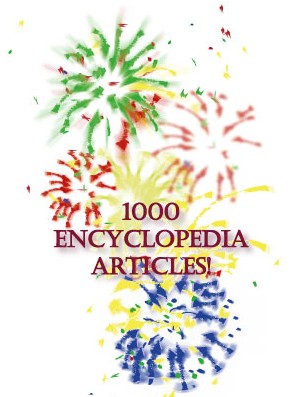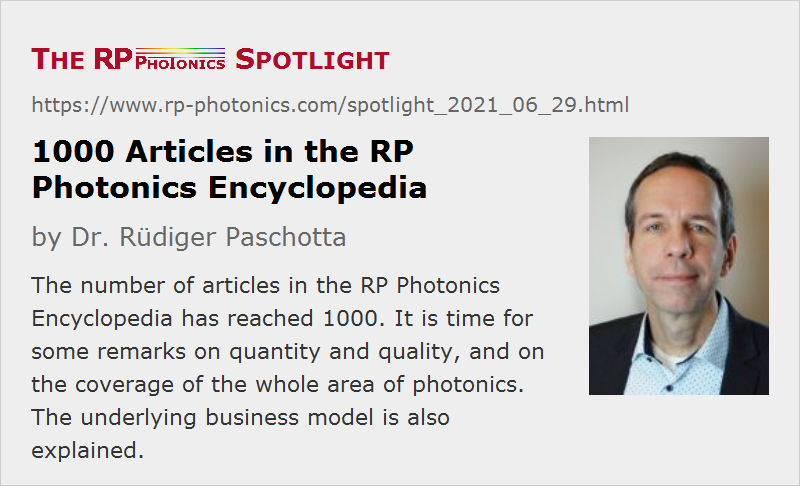1000 Articles in the RP Photonics Encyclopedia
Posted on 2021-06-29 as part of the Photonics Spotlight (available as e-mail newsletter!)
Permanent link: https://www.rp-photonics.com/spotlight_2021_06_29.html
Author: Dr. Rüdiger Paschotta, RP Photonics AG, RP Photonics AG
Abstract: The number of articles in the RP Photonics Encyclopedia has reached 1000. It is time for some remarks on quantity and quality, and on the coverage of the whole area of photonics. The underlying business model is also explained.

Yesterday, I have published article number 1000 of the RP Photonics Encyclopedia. For that, I have chosen a particularly interesting topic, namely photonic crystals. That topic has been touched here and there already, namely in the context of photonic crystal fibers, but an article on photonic crystals generally had been missing so far. While the sophisticated mathematics required for a complete understanding would go far beyond the scope of an encyclopedia article, I think it gives a useful introduction to anyone who wants to understand the basic ideas and principles as well as the typical applications.
Quantity and Quality

I emphasize that it is by no means a priority for me to push the number of articles to 1000. After all, users reading an article will not specifically be happy to know that there are 999 others; what counts, is obviously how useful the available articles are. And usefulness for the photonics community is of course the criterion.
Therefore, I continuously spend substantial time on improving existing articles in many respects – for example, adding remarks on additional topics, references or figures, improving explanations, etc.
By the way, a substantial part of that work is triggered by questions and comments entered by users. For example, they often show me what sort of things users have in mind and what might also help them. For the selection of questions and comments to be answered and published, usefulness for the community is again the central criterion.
Covering the Area of Photonics
More important than quantity as such is – besides quality of course – a good coverage of the area of photonics. When I started to develop the encyclopedia in 2004, it was called the Encyclopedia of Laser Physics and Technology. Years later, I renamed it to RP Photonics Encyclopedia in order to emphasize that it was more and more expanded to cover much of the area of photonics. For example, the encyclopedia now treats a wide range of non-laser light sources (e.g. gas discharge lamps), fundamental topics of optics (e.g. imaging), and it also presents substantial insight into laser applications such as laser material processing. The latter topic has been a focus of this year, including detailed articles on topics like laser cutting, drilling, welding and soldering, 3D printing, laser cleaning etc.
Due to the many years, in which the encyclopedia was focused on the areas lasers, nonlinear optics and fiber optics, many still seem to regard it primarily as a resource on those topics, forming a core area of photonics. However, I expect that it is more and more seen as a resource for photonics as a whole.
That broad coverage has become important mainly due to the start of the RP Photonics Buyer's Guide in 2012. It is desirable for our advertisers that there are as many encyclopedia articles as possible related to their products. This brings more people with such interest to our website, and also we display the product descriptions of the advertisers in corresponding encyclopedia articles. Further, those articles present opportunities for special promotions, for example for application notes, white papers and videos. Although for around 70% of the available product categories there is already a related encyclopedia article, some are still not covered, and those topics are relatively high on my list. But again, quality has priority over quantity and speed.
The Business Model
Many may have wondered how somebody can invest so much time and energy into a huge resource which helps the whole photonics community for free. In its infancy, the encyclopedia just helped my consulting services and simulation software to become well-known. Now it is primarily the firm and unique basis of the buyer's guide; it is the decisive reason why this photonics buyer's guide became far more popular than any other one, and thus also the most effective resource for digital photonics marketing. After about nine years, more and more marketing people are recognizing that, start to work with us, and usually then stay with us for many years. And the substantial turnover generated by the buyer's guide is of course providing a good motivation for me to maintain and develop further this resource. Indeed, I consider that as a substantial part of the future of RP Photonics.
Sponsors

I also thank once again the sponsors of the encyclopedia. They explicitly support this resource, which strongly benefits the whole photonics community, and of course get recognition for that. So far, they are all also customers using the ad package in the RP Photonics Buyer's Guide, although that is not a necessary condition.
Of course, sponsoring is very different from direct product marketing. It is primarily an instrument for branding. The benefits for the sponsors are not as obvious (and easy to prove) as those of publishing their product descriptions in our buyer's guide, which directly generates sales leads. Anyway, some suppliers care a lot about their brand and do something to develop it further – while presumably also happily supporting what helps the community. We could still take a couple of more on board; if you are interested, just contact me.
This article is a posting of the Photonics Spotlight, authored by Dr. Rüdiger Paschotta. You may link to this page and cite it, because its location is permanent. See also the RP Photonics Encyclopedia.
Note that you can also receive the articles in the form of a newsletter or with an RSS feed.
Questions and Comments from Users
Here you can submit questions and comments. As far as they get accepted by the author, they will appear above this paragraph together with the author’s answer. The author will decide on acceptance based on certain criteria. Essentially, the issue must be of sufficiently broad interest.
Please do not enter personal data here; we would otherwise delete it soon. (See also our privacy declaration.) If you wish to receive personal feedback or consultancy from the author, please contact him, e.g. via e-mail.
By submitting the information, you give your consent to the potential publication of your inputs on our website according to our rules. (If you later retract your consent, we will delete those inputs.) As your inputs are first reviewed by the author, they may be published with some delay.


Connect and share this with your network:
Follow our specific LinkedIn pages for more insights and updates: